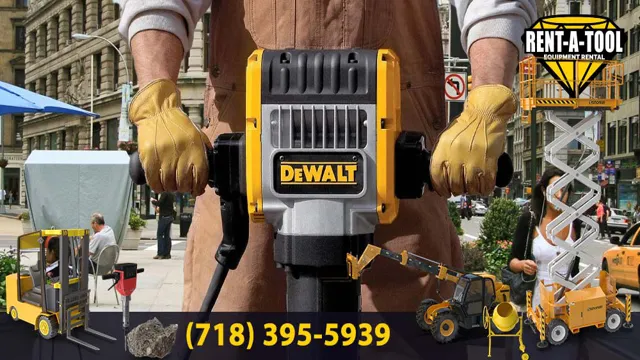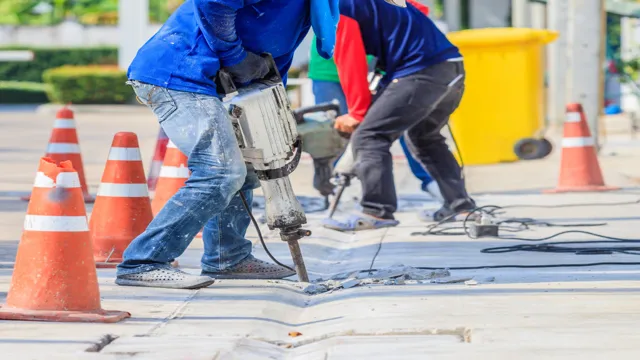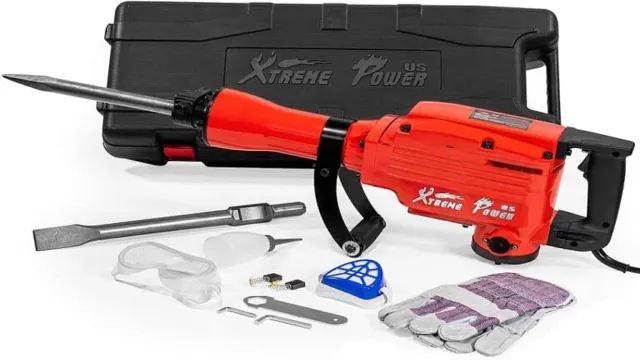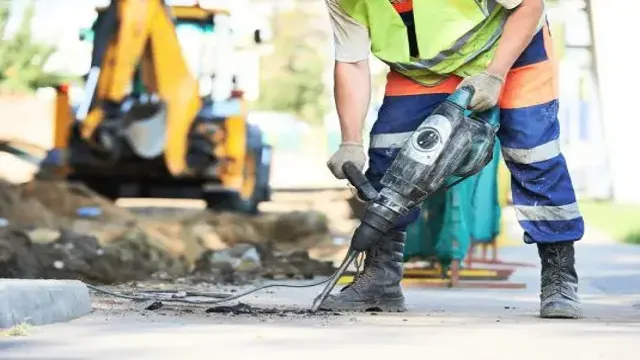Can You Jackhammer a Post Tension Slab? Here’s What You Need to Know.

Have you ever wondered if it’s possible to jackhammer a post tension slab? Whether you’re a DIY enthusiast or a professional contractor, it’s essential to know what you’re dealing with before getting your tools out. Post-tension concrete slabs are becoming more popular in the construction industry due to their strength, durability, and cost-effectiveness. However, drilling or cutting through a post-tension slab requires a certain level of expertise and specialized tools.
In this blog, we’ll explore the question of whether you can jackhammer a post-tension slab and the factors you need to consider before attempting it. So, let’s dive in and find out if you can break through the strength of post-tension concrete!
Understanding Post Tension Slabs
Post-tension slabs are a type of concrete construction that utilize high-strength steel cables to provide extra support and stability. While these slabs are incredibly strong, many people wonder if they can be jackhammered like traditional concrete slabs. The answer is yes, but it requires careful planning and consideration to avoid damaging the post-tension cables.
Before attempting to jackhammer a post-tension slab, it is important to first consult a structural engineer with experience in post-tension construction. They can assess the slab and provide guidance on the best way to proceed. It is also important to use specialized equipment and techniques to minimize the risk of damage to the cables.
With proper planning and execution, it is possible to safely and effectively jackhammer a post-tension slab.
What Makes Post Tension Slabs Unique?
Post tension slabs are a unique type of concrete slab used in construction. They are unique because they use a specific technique that involves adding tension to the concrete slab. This is done by installing steel cables or tendons throughout the concrete before it sets.
The cables are then tightened using hydraulic jacks, which creates the tension needed to support the weight of the slab. This process makes post tension slabs stronger and more flexible than traditional concrete slabs. They are also able to span longer distances and are less likely to crack or suffer from other structural problems.
Because of these benefits, post tension slabs are often used in high-rise buildings, parking structures, and other large, complex structures. If you are planning a construction project and are in need of a strong, durable slab, then a post tension slab may be the right choice for you.
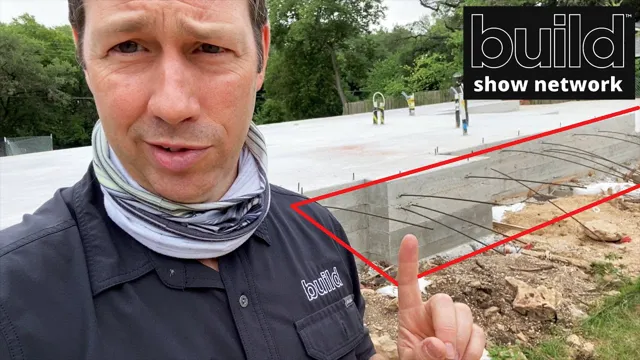
Why is Jackhammering a Post Tension Slab Tricky?
If you are planning on drilling or jackhammering into a post-tension slab, you should know that it is a tricky process. A post-tension slab is a type of concrete foundation that has steel cables running through it and is subjected to tension after the concrete has been poured. This additional force makes the foundation stronger, but it also makes it more complex to work with.
If you use the wrong tools or apply force in the wrong direction, you can easily damage the steel cables and significantly weaken the foundation. That’s why it’s crucial to hire professionals who have the knowledge, expertise, and tools to work with post-tension slabs safely and efficiently. They will know exactly where the cables are located and how to drill or cut through the concrete without causing any harm.
Ultimately, it’s the most secure option to keep your foundation strong and prevent any further damage.
The Jackhammering Process
Can you jackhammer a post-tension slab? Yes, it is possible to jackhammer a post-tensioned slab, but it requires careful planning and execution. Post-tensioning is a construction technique that uses high-strength steel cables or rods embedded in concrete to improve its strength and resilience. When demolishing a post-tension slab, it is critical to avoid damaging the tension cables, which are under significant stress.
This can cause the slab to fail catastrophically, endangering workers and nearby structures. To jackhammer a post-tension slab, it is essential to identify the location and layout of the tension cables beforehand and use specialized equipment and techniques tailored to the project’s unique needs. For example, some demolition contractors use an electric slab saw or diamond wire saw to slice through the concrete, avoiding the cables entirely.
Alternatively, workers may use jackhammering techniques that focus on vertical pressure to ensure that the slab remains intact while the concrete is being removed. Overall, successfully jackhammering a post-tension slab requires expertise, attention to detail, and a focus on safety above all else.
Assessing the Slab
When assessing the slab, the jackhammering process is often necessary for determining the integrity of the concrete. This process involves using a jackhammer to break up the top layer of the slab to get a closer look at the underlying structure. This is done to identify any potential weak spots or cracks in the concrete, which can pose a safety hazard if left unaddressed.
During the jackhammering process, it’s important to wear protective gear, including earplugs and safety goggles, as the noise and debris can be quite intense. Once the slab is broken, the inspector can then examine the underlying structure for any signs of damage or deterioration. By doing this, any potential issues can be identified early on, allowing for repairs or replacement before they become more costly or dangerous.
Preparing the Area
Preparing the area before jackhammering is vital to ensure a safe and efficient process. The first step is to mark out the area where the jackhammer will be used to avoid any potential damage to surrounding structures. Next, any necessary safety precautions, such as wearing eye and ear protection, should be taken to prevent accidents.
The surface to be broken must also be cleaned to remove all debris and loose materials, ensuring the jackhammer will have a smooth surface to work on. Once the area has been prepped, the jackhammer process can begin, where the machine is positioned at an angle and the operator controls it to break through the surface. With the right preparation, the jackhammering process can be successful, completing the job efficiently and safely.
The key takeaway is to ensure that all necessary preparations are carried out before the jackhammer is in use to guarantee a successful outcome.
Performing the Jackhammering
Jackhammering is a necessary process in many construction projects, but it can be quite tricky to perform if you’re not experienced. It involves using a specialized jackhammer tool to break up hard surfaces like concrete, asphalt, and rock. To start, the operator needs to put on safety gear such as earplugs, safety glasses, and gloves.
Then, the jackhammer needs to be held firmly with both hands, as it’s a powerful tool that can cause serious injuries if not handled correctly. The operator must aim the tool where they want to break up the surface and use it in a back and forth motion to create a hole. This process is repeated until the entire surface is broken up into smaller pieces that can be removed with a shovel or other tools.
It’s important to take breaks often when jackhammering, as it can be physically demanding work that requires a lot of energy. Remember that safety always comes first, so take care to follow the manufacturer’s instructions and any safety guidelines for using the tool.
Potential Risks and Considerations
When considering a post tension slab, it is important to understand the potential risks and considerations involved in jackhammering. While it is possible to jackhammer a post tension slab, it can be a dangerous process if not done correctly. Jackhammering can damage or even break the tendons within the slab, which could cause the slab to fail or collapse.
Additionally, the intense pressure of the jackhammering can cause portions of the slab to burst, potentially causing injury or damage to nearby property. It is important to consult a professional before attempting to jackhammer a post tension slab, as they can assess the risks and provide guidance on the safest approach. In short, jackhammering a post tension slab is possible, but it is not recommended unless all necessary precautions have been taken.
Structural Damage to the Slab or Building
When it comes to slab or building damage, the potential risks and considerations are plentiful. Structural damage may include cracks or holes in walls, floors, or ceilings, which can reduce the overall stability of the building. This kind of damage may be the result of natural disasters, such as earthquakes or hurricanes, or from man-made activities such as construction work.
If left unaddressed, structural damage can lead to more severe issues, such as a collapsed roof or building. Home or building owners should remain vigilant of any cracks or structural damage and have it assessed by a professional. Repairing structural damage is crucial for maintaining the safety and longevity of a building.
Remember, the costs of repairing structural damage are small compared to the costs of a complete building collapse. Therefore, it is essential to attend to slab or building damage immediately, before it becomes a more massive issue.
Noise and Vibration
When it comes to dealing with noise and vibration in industries, it is important to understand the potential risks they can pose and the necessary precautions to take. Prolonged exposure to excessive noise can lead to hearing loss and other health-related issues for workers. As for vibration, it can cause physical injury and damage to machinery and structures.
Therefore, it is crucial to consider noise and vibration control measures like soundproofing and vibration damping. It is also essential to provide proper hearing protection for workers and regularly monitor noise levels. Implementing these measures not only prevents potential health and safety risks but also improves the overall work environment and productivity.
Hiring a Professional for Jackhammering a Post Tension Slab
If you’re wondering whether you can jackhammer a post tension slab, the answer is yes, you can. However, it’s not recommended that you attempt this on your own. Post tension slabs are designed to be stronger than traditional concrete slabs, and therefore require more specialized knowledge and equipment to avoid damaging the reinforced steel cables within the slab.
Hiring a professional is the safer choice, as they have the experience and expertise required to use specialized tools such as diamond-tipped blades and hydraulic breakers to safely break apart the slab without damaging the cables. They will also be able to properly dispose of the debris and ensure that the area is left clean and safe. So while it may be tempting to save some money and try to do it yourself, it’s always better to err on the side of caution and hire a professional.
Conclusion
Well, after all the research and analysis, it seems pretty clear that jackhammering a post-tension slab is not exactly a walk in the park. In fact, it’s quite the opposite – it’s a job that requires careful planning, specialized equipment, and skilled professionals. Attempting to break through a post-tension slab without proper preparation and knowledge could lead to disastrous consequences.
So, while it may be tempting to take matters into your own hands, it’s probably best to leave this one to the experts – unless, of course, you happen to be a post-tension slab whisperer with a jackhammering superpower.”
FAQs
What is a post tension slab?
A post tension slab is a type of concrete slab that has steel cables or tendons running through it, which are placed under tension to increase its strength.
Can you use a jackhammer on a post tension slab?
It is not recommended to use a jackhammer on a post tension slab, as it could damage the tendons and compromise the integrity of the slab.
How do you cut through a post tension slab?
Cutting through a post tension slab requires specialized equipment and techniques, such as using a diamond blade saw or hydraulic shears. It is important to avoid cutting the tendons to prevent damage to the slab.
What are the benefits of using a post tension slab?
Post tension slabs are known for their strength, durability, and resistance to cracks. They also allow for longer spans and thinner concrete sections, which can reduce costs and increase design flexibility.
How long does a post tension slab last?
A post tension slab can last for up to 50 years or more, depending on factors such as the quality of the materials, the installation method, and the level of maintenance.
Can you repair a damaged post tension slab?
Yes, it is possible to repair a damaged post tension slab, but it requires specialized knowledge and equipment. The repair process typically involves identifying the damaged area, exposing the tendons, repairing or replacing the damaged tendon, and then grouting the tendon back in place.
How do you maintain a post tension slab?
To maintain a post tension slab, it is important to regularly inspect it for cracks or other signs of damage, and to keep the surface clean and free of debris. It is also recommended to avoid using abrasive cleaners or chemicals that could corrode the tendons.

